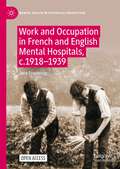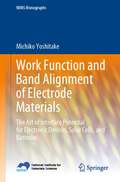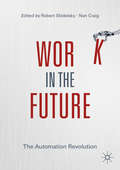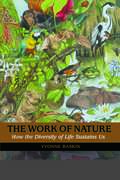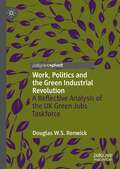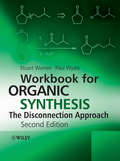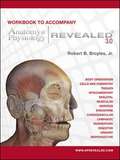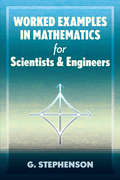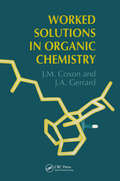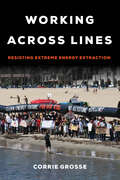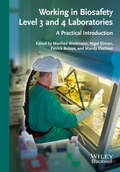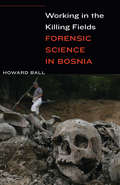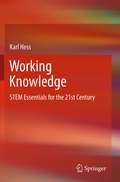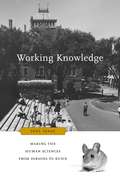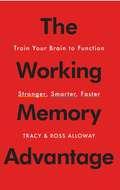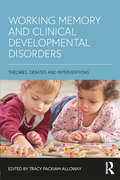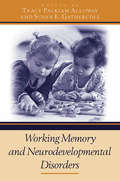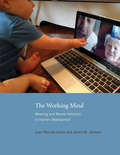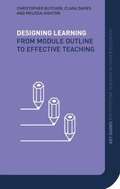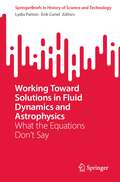- Table View
- List View
Work and Occupation in French and English Mental Hospitals, c.1918-1939 (Mental Health in Historical Perspective)
by Jane FreebodyThis open access book demonstrates that, while occupation has been used to treat the mentally disordered since the early nineteenth century, approaches to its use have varied across different countries and in different time periods. Comparing how occupation was used in French and English mental institutions between 1918 and 1939, one hundred years after the heyday of moral therapy, the book is an essential read for those researching the history of mental health and medicine more generally. It provides an overview of the legislation, management structures and financial conditions that affected mental institutions in France and England, and contributed to their differing responses to the new theories of occupational therapy emerging from the USA and Germany during the interwar period.
Work Function and Band Alignment of Electrode Materials: The Art of Interface Potential for Electronic Devices, Solar Cells, and Batteries (NIMS Monographs)
by Michiko YoshitakeThis book covers a wide range of topics on work function and band alignment, from the basics to practical examples. Work function and band alignment determine electric properties at the interface including surfaces, such as electron emission, the Schottky barrier height, and ohmic contact. Basic physics is used to systematically explain how to adjust and measure work function and how to modify the band alignment required for controlling work function in functional materials and electrodes. Methods introduced in the book help to improve device performance and to solve the problems of controlling the voltage and efficiency of devices in a great variety of applications, including electronic devices, optical devices such as displays, and energy devices such as solar cells and batteries. Understanding the technical methods necessary for controlling work function and band alignment can help to solve problems such as non-ohmic contact at source–electrode or drain–electrode interfaces in metal–oxide–silicon structures, which directly contributes to improving power saving and reducing heat generation in computers.
Work in the Future: The Automation Revolution
by Robert Skidelsky Nan CraigThis short, accessible book seeks to explore the future of work through the views and opinions of a range of expertise, encompassing economic, historical, technological, ethical and anthropological aspects of the debate. The transition to an automated society brings with it new challenges and a consideration for what has happened in the past; the editors of this book carefully steer the reader through future possibilities and policy outcomes, all the while recognising that whilst such a shift to a robotised society will be a gradual process, it is one that requires significant thought and consideration.
The Work of Nature: How The Diversity Of Life Sustains Us
by Harold A. Mooney Yvonne Baskin Jane Lubchenco Abigail Rorer Paul R. Ehrlich"We do not question that flesh and bone and leaf litter will decay to dust, that seeds will sprout season after season and find renewed nourishment in the soil, that rivers can flow endlessly without running dry, that we can breathe a lifetime without depleting the air of oxygen.... What humans have not fully appreciated until recently is that these services are the work of nature, performed by the rich diversity of microbes, plants, and animals on the earth." --from The Work of NatureThe lavish array of organisms known as "biodiversity" is an intricately linked web that makes the earth a uniquely habitable planet. Yet pressures from human activities are destroying biodiversity at an unprecedented rate. How many species can be lost before the ecological systems that nurture life begin to break down?In The Work of Nature, noted science writer Yvonne Baskin examines the threats posed to humans by the loss of biodiversity. She summarizes and explains key findings from the ecological sciences, highlighting examples from around the world where shifts in species have affected the provision of clean air, pure water, fertile soils, lush landscapes, and stable natural communities.As Baskin makes clear, biodiversity is much more than number of species -- it includes the complexity, richness, and abundance of nature at all levels, from the genes carried by local populations to the layout of communities and ecosystems across the landscape. Ecologists are increasingly aware that mankind's wanton destruction of living organisms -- the planet's work force -- threatens to erode our basic life support services. With uncommon grace and eloquence, Baskin demonstrates how and why that is so.Distilling and bringing to life the work of the world's leading ecologists, The Work of Nature is the first book of its kind to clearly explain the practical consequences of declining biodiversity on ecosystem health and function.
The Work of the Zoo Doctors at the San Diego Zoo (Zoo World)
by Georgeanne IrvineDescribes the work of the veterinarians at the San Diego Zoo as they treat sick and injured animals and work to save species through conservation and breeding programs. Other books by this author are available in this library.
Work, Politics and the Green Industrial Revolution: A Reflective Analysis of the UK Green Jobs Taskforce
by Douglas W.S. RenwickIn 2020, UK Prime Minister Boris Johnson launched The Green Jobs Taskforce, which extended and articulated the green jobs policy of his government and its position within conservative political ideology. This book critically highlights gaps in the political and business decision-making of his Taskforce, most notably on: the limited role of employers and HRM associations in skills building for staff in non-polluter industries (solar and wind); issues of a fair and just transition for workers losing jobs in the polluter industries (fossil fuels); and the lack of employee voice in both work arenas. The overtly pro-conservative and political nature of this UK Taskforce is also analyzed, which occurs and operates in opposition to British trade unions and the wider labor movement, by not prioritizing the just transition, alongside the extensive skills, training and passporting requirements that British workers need to gain decent, green jobs.This book is distinctive in offering the first in-depth analysis and critique of the UK Green Jobs Taskforce, in examining this Taskforce using conservative political ideas, and by critiquing it too. Little academic literature is available globally on the business impact and analysis of UK governmental sustainability policy, and this study can provide wider learning points, lessons and implications for other green job plans being formed and enacted in the EU, USA and other countries. It will be of great interest to academics and students of sustainability, HRM, organizational behavior, organization studies and employment relations.
Workbook for Organic Synthesis: The Disconnection Approach
by Paul Wyatt Stuart WarrenOne approach to organic synthesis is retrosynthetic analysis. With this approach chemists start with the structures of their target molecules and progressively cut bonds to create simpler molecules. Reversing this process gives a synthetic route to the target molecule from simpler starting materials. This "disconnection" approach to synthesis is now a fundamental part of every organic synthesis course.Workbook for Organic Synthesis: The Disconnection Approach, 2nd EditionThis workbook provides a comprehensive graded set of problems to illustrate and develop the themes of each of the chapters in the textbook Organic Synthesis: The Disconnection Approach, 2nd Edition. Each problem is followed by a fully explained solution and discussion. The examples extend the student's experience of the types of molecules being synthesised by organic chemists, and the strategies they employ to control their syntheses. By working through these examples students will develop their skills in analysing synthetic challenges, and build a toolkit of strategies for planning new syntheses. Examples are drawn from pharmaceuticals, agrochemicals, natural products, pheromones, perfumery and flavouring compounds, dyestuffs, monomers, and intermediates used in more advanced synthetic work. Reasons for wishing to synthesise each compound are given. Together the workbook and textbook provide a complete course in retrosynthetic analysis.Organic Synthesis: The Disconnection Approach, 2nd EditionThere are forty chapters in Organic Synthesis: The Disconnection Approach, 2nd Edition: those on the synthesis of given types of molecules alternate with strategy chapters in which the methods just learnt are placed in a wider context. The synthesis chapters cover many ways of making each type of molecule starting with simple aromatic and aliphatic compounds with one functional group and progressing to molecules with many functional groups. The strategy chapters cover questions of selectivity, protection, stereochemistry, and develop more advanced thinking via reagents specifically designed for difficult problems. In its second edition updated examples and techniques are included and illustrated additional material has been added to take the student to the level required by the sequel, Organic Synthesis: Strategy and Control. Several chapters contain extensive new material based on courses that the authors give to chemists in the pharmaceutical industry.Workbook for Organic Synthesis: The Disconnection Approach, 2nd edition, combined with the main textbook, provides a full course in retrosynthetic analysis for chemistry and biochemistry students, and a refresher course for organic chemists working in industry and academia.
Workbook Pacemaker General Science (Third Edition)
by FearonThis program introduces students to the basic concepts and principles of life, earth, and physical science and builds the fundamental science skills students of all ability levels need to succeed. The program is supported with expanded real-world activities, test preparation, and comprehensive reviews that help students make the important connections between science and their own lives. In addition, students are encouraged to apply newly learned concepts using hands-on discovery through lab exercises and enrichment activities. Lexile Level 750 Reading Level 3-4 Interest Level 6-12
Workbook to Accompany Anatomy And Physiology Revealed 3.0
by Robert BroylesThe Workbook to Accompany Anatomy and Physiology Revealed, Version 3 by Robert Broyles is a workbook/study guide designed to help students get the most they can out of the Anatomy and Physiology Revealed (APR), and out of their anatomy and physiology course. The Table of Contents closely follows APR 3.0, and is organized along the lines of a typical Anatomy and Physiology course. The individual exercises include art from APR and also have review questions, tables, coloring exercises, terminology quiz questions, and reminders on key content.
Worked Examples in Mathematics for Scientists and Engineers (Dover Books on Mathematics)
by G. StephensonThis rich collection of fully worked problems in many areas of mathematics covers all the important subjects students are likely to encounter in their courses, from introductory to final-year undergraduate classes. Because lecture courses tend to focus on theory rather than examples, these exercises offer a valuable complement to classroom teachings, promoting the understanding of mathematical techniques and helping students prepare for exams. They will prove useful to undergraduates in mathematics; students in engineering, physics, and chemistry; and postgraduate scientists looking for a way to refresh their skills in specific topics.The problems can supplement lecture notes and any conventional text. Starting with functions, inequalities, limits, differentiation, and integration, topics encompass integral inequalities, power series and convergence, complex variables, hyperbolic function, vector and matrix algebra, Laplace transforms, Fourier series, vector calculus, and many other subjects.
Worked Examples in Nonlinear Continuum Mechanics for Finite Element Analysis
by Javier Bonet Antonio J. Gil Richard D. WoodMany processes in materials science and engineering, such as the load deformation behaviour of certain structures, exhibit nonlinear characteristics. The computer simulation of such processes therefore requires a deep understanding of both the theoretical aspects of nonlinearity and the associated computational techniques. This book provides a complete set of exercises and solutions in the field of theoretical and computational nonlinear continuum mechanics and is the perfect companion to Nonlinear Continuum Mechanics for Finite Element Analysis, where the authors set out the theoretical foundations of the subject. It employs notation consistent with the theory book and serves as a great resource to students, researchers and those in industry interested in gaining confidence by practising through examples. Instructors of the subject will also find the book indispensable in aiding student learning.
Worked Solutions in Organic Chemistry
by James M. CoxonThis book illustrates and teaches the finer details of the tactics and strategies employed in the synthesis of organic molecules. As well as providing model answers to the problems, the book discusses, in detail, the reasons why particular strategies are chosen, and why, in given circumstances, alternative methods or routes may or may not be appropriate. As such it could be used as a stand alone volume for the teaching of organic chemistry with a modern and appropriate emphasis on synthesis. Extensive cross referencing to Principles of Organic Synthesis allows the two books to be used as companion volumes.
Working across Lines: Resisting Extreme Energy Extraction
by Corrie GrosseHow are communities uniting against fracking and tar sands to change our energy future? Working across Lines offers a detailed comparative analysis of climate justice coalitions in California and Idaho—two states with distinct fossil fuel histories, environmental contexts, and political cultures. Drawing on ethnographic evidence from 106 in-depth interviews and three years of participant observation, Corrie Grosse investigates the ways people build effective energy justice coalitions across differences in political views, race and ethnicity, age, and strategic preferences. This book argues for four practices that are critical for movement building: focusing on core values of justice, accountability, and integrity; identifying the roots of injustice; cultivating relationships among activists; and welcoming difference. In focusing on coalitions related to energy and climate justice, Grosse provides important models for bridging divides to reach common goals. These lessons are more relevant than ever.
Working in Biosafety Level 3 and 4 Laboratories: A Practical Introduction
by Manfred Weidmann Nigel Silman Patrick Butaye Mandy ElschnerThe first training manual for new staff working in BSL3/4 labs. This guide is based on a course developed in 2007 by the EU COST action group 28b which serves as a standard for many courses BSL3/4 training courses worldwide. The four-day course consists of lectures and practical training with the lecturers covering all the different possibilities of organising a BSL-3/4 lab including the adaptation to the local requirements of biosafety, safety at work, and social regulations. This book covers bio-containment, hazard criteria and categorisation of microbes, technical specifications of BSL-3 laboratories and ABSL-3 laboratories, personal protective gear, shipping BSL-3 and BSL-4 organisms according to UN and IATA regulations, efficacy of inactivation procedures, fumigation, learning from a history of lab accidents, handling samples that arrive for diagnostic testing and bridging the gap between the requirements of bio-containment and diagnostics. Course participants can not only use the book for their actual training event but it will remain a useful reference throughout their career in BSL3/4 labs.
Working in the Killing Fields: Forensic Science in Bosnia
by Howard BallWhile the specifics of individual wars vary, they share a common epilogue: the task of finding and identifying the “disappeared.” The Bosnian war of the early 1990s, which destroyed the sovereign state of Yugoslavia, is no exception. In Working in the Killing Fields, Howard Ball focuses on recent developments in the technology of forensic science and on the work of forensic professionals in Bosnia following that conflict. Ball balances the examination of complex features of new forensic technology with insights into the lives of the men and women from around the globe who are tasked with finding and excavating bodies and conducting pathological examinations. Having found the disappeared, however, these same pathologists must then also explain the cause of death to international-court criminal prosecutors and surviving families of the victims. Ball considers the physical dangers these professionals regularly confront while performing their site excavations, as well as the emotional pain, including post-traumatic stress disorder, they contend with while in Bosnia and after they leave the killing fields.Working in the Killing Fields integrates discussion of cutting-edge forensic technology into a wider view of what these searches mean, the damage they do to people, and the healing and good they bring to those in search of answers. Even though the Balkan wars took place two decades ago, the fields where so many men, women, and children died still have gruesome and disturbing stories to tell. Ball puts the spotlight on the forensic professionals tasked with telling that story and on what their work means to them as individuals and to the wider world’s understanding of genocide and war.
Working Knowledge
by Karl HessWorking Knowledge: STEM Essentials for the 21st Century is designed to inspire a wide range of readers from high school and undergraduate students with an interest in Science, Technology, Engineering, and Mathematics (STEM) to STEM teachers and those who wish to become teachers. Written by renowned scientist and teacher Dr. Karl Hess of the University of Illinois at Urbana, a member of both the National Academy of Sciences and the National Academy of Engineering, the book presents a critical collection of timeless STEM concepts and connects them with contemporary research advances in addition to the needs of our daily lives. With an engaging and accessible style not requiring a formal background in STEM, Dr. Hess takes the reader on a journey from Euclidean Geometry and Cartesian Coordinates up through 21st Century scientific topics like the global positioning system, nanotechnology, and super-efficient alternative energy systems. Working Knowledge: STEM Essentials for the 21st Century at once serves as an almanac on the fascinating physical, chemical, quantitative features of the natural world and built environment, as well as a need-to-know list of topics for students, teachers, and parents interested in STEM education.
Working Knowledge: Making The Human Sciences From Parsons To Kuhn
by Joel IsaacIsaac explores how influential thinkers in the mid-twentieth century understood the relations among science, knowledge, and the empirical study of human affairs. He places special emphasis on the practical, local manifestations of their complex theoretical ideas, particularly the institutional milieu of Harvard University.
The Working Memory Advantage: Train Your Brain to Function Stronger, Smarter, Faster
by Ross Alloway Tracy AllowayA bigger asset than IQ: The first book to introduce the newly discovered--and vitally important--mental skill known as working memory, showing how it is crucial to our success in work and life and how to strengthen it.Working memory--your ability to work with information--influences nearly everything you do. What if you could find a way to better handle a crazy schedule or expertly manage risks? What if you could gain an advantage in climbing the career ladder or in school or sports? What if there were a way to improve your outlook on life, to face each day with more optimism and confidence? Tracy and Ross Alloway, leading experts in the field, show how working memory is the key to all that and more. They present important recent findings, including research on how Facebook can help with working memory, how working memory can improve your kids' grades, how it changes as you age, and how working memory is linked with ADHD, autism, dyslexia, and Alzheimer's. The Alloways describe their Jungle Memory program, which Ross created to help children improve their working memories, and is rapidly being embraced by the education community. Most importantly, they share the best news: you can improve your memory! Their book provides three tests to find out how good your working memory is--and more than fifty targeted exercises designed to help readers both process and memorize the information to maximize effectiveness. The Working Memory Advantage offers unprecedented insight into one of the most important cognitive breakthroughs in recent years--a vital new approach to making your brain stronger, smarter, and faster.
The Working Memory Advantage
by Tracy Alloway Ross AllowayAs revolutionary as Emotional Intelligence, this is the first book to explore the tremendous importance of working memory--a stronger predictor of success in life than IQ--and provide a wealth of simple exercises for enhancing this crucial skill.Working memory--the ability to hold and process incoming information actively in one's mind--lies at the heart of most important life functions. Learning, decision-making, prioritization, time management, and multitasking all rely on working memory. Research has also shown that it is a key determinant of happiness; people with strong working memory are more optimistic and more hopeful about the future. Tracy Alloway and her husband Ross, leading experts on this subject, present not only their own findings, but all of the most important recent breakthroughs in the field, including studies that show that many children with learning problems and ADD have weak working memories. The good news is that working memory can be improved, and the authors offer a host of simple exercises that can help everyone make significant and lasting gains in brain function. Equal parts descriptive and prescriptive, The Working Memory Advantage offers unprecedented insight into one of the most important psychological breakthroughs of the past ten years--and a vital new approach to maximizing mental performance.
Working Memory and Clinical Developmental Disorders: Theories, Debates and Interventions
by Tracy Packiam AllowayThis comprehensive volume brings together international experts involved in applying and developing understanding of Working Memory in the context of a variety of neurodevelopmental disorders, neurocognitive disorders, and depressive disorders. Each chapter provides a description of the disorder and investigates the Working Memory and related Executive Function deficits. It goes on to provide a neurological profile, before exploring the impact of the disorder in daily functions, the current debates related to this disorder, and the potential effects of medication and intervention. Through combining coverage of theoretical understanding, methods of assessment, and different evidence-based intervention programs, the book supports clinical assessment and management of poor Working Memory. It is essential reading for students in neurodevelopmental disorders, atypical development and developmental psychopathology as well as allied health professionals, clinicians and those working with children in education and healthcare settings.
Working Memory and Neurodevelopmental Disorders
by Susan E. Gathercole Tracy Packiam AllowayShort-term or working memory - the capacity to hold and manipulate information mentally over brief periods of time - plays an important role in supporting a wide range of everyday activities, particularly in childhood. Children with weak working memory skills often struggle in key areas of learning and, given its impact on cognitive abilities, the identification of working memory impairments is a priority for those who work with children with learning disabilities. Working Memory and Neurodevelopmental Disorders supports clinical assessment and management of working memory deficits by summarising the current theoretical understanding and methods of assessment of working memory. It outlines the working memory profiles of individuals with a range of neurodevelopmental disorders (including Down's syndrome, Williams syndrome, Specific Language Impairment, and ADHD), and identifies useful means of alleviating the anticipated learning difficulties of children with deficits of working memory. This comprehensive and informative text will appeal to academics and researchers in cognitive psychology, neuropsychology and developmental psychology, and will be useful reading for students in these areas. Educational psychologists will also find this a useful text, as it covers the role of working memory in learning difficulties specific to the classroom.
The Working Mind: Meaning and Mental Attention in Human Development
by Juan Pascual-Leone Janice M. JohnsonA general organismic-causal theory that explicates working memory and executive function developmentally, clarifying the nature of human intelligence.In The Working Mind, Juan Pascual-Leone and Janice M. Johnson propose a general organismic-causal theory that explicates working memory and executive function developmentally and by doing so clarifies the nature of human intelligence. Pascual-Leone and Johnson explain "from within" (that is, from a subject's own processing perspective) cognitive developmental stages of growth, describing key causal factors that can account for the emergence of the working mind as a functional totality. Among these factors is a maturationally growing mental attention.
Working One-to-one With Students: Supervising, Coaching, Mentoring, And Personal Tutoring
by Jane Clarke Kate Exley Gina Wisker Maria Antoniou Pauline RidleyWorking One-to-One with Studentsis written for Higher Education academics, adjuncts, teaching assistants and research students who are looking for guidance inside and outside the classroom. This book is a jargon-free, practical guide to improving one-to-one teaching, covering a wide range of teaching contexts, including mentoring students and staff, supervising dissertations and how to approach informal meetings outside of lectures. Written in an engaging, accessible style and grounded in experience, this book offers a combination of practical advice backed by relevant learning theory. Featuring a wealth of case studies and useful resources, the book covers areas including: Supporting students Encouraging independent learning Mentoring coaching and personal tutoring Developing peer groups and buddying programs Dealing with diversity, difficult students and ethical dilemmas supervising the undergraduate dissertation Supervising postgraduates in the arts, social sciences and sciences. This book is a short, snappy, practical guide that covers this key element of a lecturer's work. In the spirit of the series (KEY GUIDES FOR EFFECTIVE TEACHING in HIGHER EDUCATION) this book covers relevant theory that effectively informs practice.
Working Toward Solutions in Fluid Dynamics and Astrophysics: What the Equations Don’t Say (SpringerBriefs in History of Science and Technology)
by Lydia Patton Erik CurielThis book focuses on continuing the long-standing productive dialogue between physical science and the philosophy of science. Researchers and readers who want to keep up to date on front-line scientific research in fluid mechanics and gravitational wave astrophysics will find timely and well-informed analyses of this scientific research and its philosophical significance. These exciting frontiers of research pose deep scientific problems, and raise key questions in the philosophy of science related to scientific explanation and understanding, theory change and assessment, measurement, interpretation, realism, and modeling. The audience of the book includes philosophers of science, philosophers of mathematics, scientists with philosophical interests, and students in philosophy, history, mathematics, and science. Anyone who is interested in the methods and philosophical questions behind the recent exciting work in physics discussed here will profit from reading this book.

